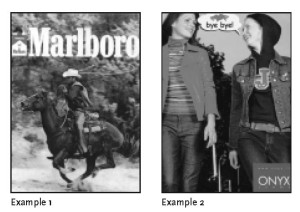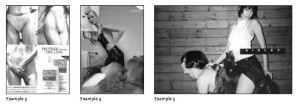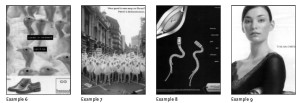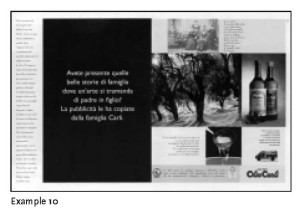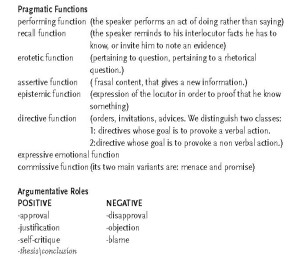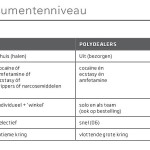ISSA Proceedings 2002 – Argumentative Mechanisms In Advertising
No comments yet We live in the age of advertising, every space in our culture carries commercial messages. They are used to give vicarious experience and to shape the consumer’s identity.
We live in the age of advertising, every space in our culture carries commercial messages. They are used to give vicarious experience and to shape the consumer’s identity.
Therefore it’s fascinating to find a way to penetrate its strategies, considering that even if we can witness an enormous amount of publications on this topic, many of them reflect much more on its general aims, instead of analyzing its mechanisms.
The language of advertising is very complex as it uses different codes, the verbal and the visual one interacting. Applying Perelman’s simplification of topoi to some advertisements taken from a corpus, collected mainly in Italian and English from women magazines, can be a first step in the inventio of this kind of argumentation. Then, in order to understand the goal of the different messages, it can be useful to apply Stati’s model of “pragmatic functions“ and “argumentative roles” (Stati, 1990, 25-90) through which we are going to interpret the illocutive force of some commercials.
This approach normally reveals that very often the real purpose of the advertisement is “disguised”. This can happen in order to invent creative and surprising effects, but also to manipulate the communication influencing the consumers indirectly. So we will briefly underline how contemporary advertising breaks even the most basically “communication rules” (Eemeren & Grootendorst, 1992, 50).
1. The topos of essence and the topos of persona
Perelmann’s assumption leads to a simplified scheme of the classical topoi. Perelman calls topoi only the general premises which make possible to ground values and hierarchies, the ones that Aristotle studies among the loci of the accident: quality, quantity, existence, essence, order and person (Perelman & Olbrechts Tyteca, 1989, 90).
Under these categories every kind of advertisement can be classified, here I am going to talk about the one of Essence and that of Persona, showing how they have been developed in the world of advertising and how they affect its audience.
Perelman calls Essence the general premises that stress the value of those who represents a particular category (We call loci of essence (…) everything that better represents a type, an essence, a function, (and) is for this same reason made valuable. (Perelman-Tyteca, 1989, 100, translation mine). In advertising a leading role is played by testimonials, who can be real people or fictional characters, the first ones ground on the topos of essence. The fictional testimonials in fact, are created on purpose to represent a particular human character or way of life, with which the audience can identify.
The Marlboro Man, (ex. 1) for instance, grounds on the “western encyclopaedia”. It is a good example of the impact of movie culture on the audience, because in this commercial, the aura of the cowboy “macho” is displayed onto the product. This enhances on the one hand the charme that the cigarettes bestow upon their users, and on the other one attempts at removing doubts of cigarettes unhealthy effects.
Besides commercials based on the concept of essence have a great impact on gender stereotypes and affect the consumer’s perception of femininity and masculinity, becoming at the same time mirror and matrix of society.
The essence of femininity has nowadays become a social space that simultaneously acts upon and is acted upon mass media discourse. According to Dorothy Smith the construction of the feminine social space is both actuated through and on the feminine body. Women contribute to this creation by disciplining their bodies to the social frames proposed by advertising:
“Women aren’t just the passive products of socialization; they are active; they create themselves. At the same time, their self creation, their work, the uses of their skills, are co-ordinated with the market.”(Hall & Bucholtz, 1995, 145)
Advertising creates not only fictional testimonials but also fictional interlocutors, in the case of feminine products, it is as if women were members of a completely different community: the world of women.
This female community does not share however the same mechanisms as the general community. It rather creates an artificial sisterhood, an intimate world, a shelter of secrets, which often leads to dynamics of comparison and jealousy. If we take teen-agers’ fashion advertising we’ll see in the majority of cases two girls dressed in a very similar way, simulating a couple of best friends to create a sense of unity and mutual understanding based on the act of consume.
Let’s take for instance the campaign of Onyx (ex. 2) a fashion label. The image does neither have headline[i] nor body-copy[ii]. The visual[iii] is staged on the road and depicts two girls dressed with the casual clothes promoted. We can infer that they are about to leave because “Bye, bye” is clearly spelled out within a white cloud like in comics. It’s a micro narration of an everyday scene, cherished by young people, as it is the moment between school and homework, a time of confidences and news. Their similarity implies an attitude of emulation to share with the young customer.
Adult women instead, are portrayed very differently, they are represented as tools that demand constant maintenance. They appear as dissected bodies whose simple parts need specific products. Images concentrate from time to time on face, eyes, feet, nails and breast, giving a synecdochtical vision of the woman (ex. 3).
The emotional universe of girls and women is also dealt with differently. The first are depicted as shameless and cheeky, while they make fun of boys: Sysley (ex. 4). The role of adult women is still instrumental to male desires, here women construct their image in connection with a man. (ex. 5)
The common place of essence can be applied also to material things or to a particular atmosphere. The essence of romanticism, as well as its exotic implication, has never ceased to exist. What has changed however is the romantic landscape.
During the XVIII century exotic overlapped with the sunny orient, now the metropolis and New York in particular has become a source of romantic imagination, the catalyzer of many stereotypes among which also that of “Sehnsucht”, a German term that evokes a nostalgic frame of mind. Most probably after September 11 this will become more and more so.
The topos of Persona too is widely adopted by the advertising discourse, which also heavier relies on real testimonials such as pop stars, politicians, top models etc. These people can be connected or disconnected from the product they promote. In the first case for instance they are used to witness the quality, they are a guarantee for the truth of the argument, as it happens with famous scientists assuring the positive effect of beauty treatments or that of sport champions who promote fitness accessories. In the second case they simply lend the power of their popularity to advertising. In the USA the campaign for dairy products “Got Milk” has created its hall of fame by using many stars sharing the good habit of drinking milk as their white moustache prove.
2. Pragmatic Functions and Argumentative Roles in advertising
The notion of loci could be further used to explore other themes, but it’s not enough to analyze the illucutory force of the messages. That’s why the analysis can be now developed using Sorin Stati’s classification of pragmatic functions and argumentative roles[iv], remembering that these two concepts are relatively similar, but only the second ones transform discourse in argumentation.
“Les fonctions pragmatiques et les rôles argumentatifs sont des facteurs sémantiques relativement semblables, dans la mesure où ils concernent les buts pousuivis par les locuteur, ses intentions communicatives.” (Stati, 1990, 16). (The pragmatic function and the argumentative roles are relatively similar factors, as they concern the goal pursued by the locutor, his communicative intentions) (translation mine).
Anyway, while the pragmatic functions are necessary conditions representing “grosso modo” the illocutory force of the speech act” (Stati, 1990, 26), the argumentative roles are not, they are an added value which can support the function or transform it completely. This distinction is particularly appropriate in the analysis of the verbal part of advertising in connection with the visual, from which we have often to infer the argumentative role.
The interaction between them is surprising because often the first hides the goal of the second one.
Let’s start the analysis with some functions taken from the scheme, underlining each time the argumentative role too:
Leader or follower? Let it be
This is the headline of the shoes Freemod, (ex. 6) which is placed in the middle of the visual. The photo shows hundreds of turkeys and down on the right, there is a small image of the promoted shoes.
Here can be recognized the erotetic function constituted by the couple: question-answer. In advertising this is a good strategy to pretend to have a direct dialogue with the consumers.
In this case the analysis demands interpretation, in other words we need to consider the visual together with the headline in order to understand the argumentative role.
“Leader or follower? Let it be” becomes a sort of dialogue between the advertiser and an hypothetical audience that doesn’t care about its own image.
That’s why the headline is put on the image of a group of turkeys as a metaphor of ordinary people, who are according to that vision similar and ugly. It’s not by chance that these kind of animals who look rather stupid have been chosen for the purpose. Going back to the erotetic function we can see that the question-answer couple here hides the argumentative role of blame.
Another example by the condom’s company Durex (ex.7) shows the same pragmatic function producing a funny effect, through a surreal image.
The headline is:
How good is new easy-on Durex?
Here’s a demonstration
This is placed on the top of an image that depicts a crowd of spermatozoon against Durex. It is a pun between demonstration meaning “protest” and at the same time ”evidence”. The argumentative role is that of an ironical approval.
Another function which is very persuasive is the epistemic, as it underscores that the speaker “knows something”. Advertiser resort to this strategy in order to convince the consumers of the quality of a particular kind of product, to show them that the producer knows what is best for the customer.
Following ad by Adidas, Deo performance for women is an example for this kind of argumentation:
“Because we understand how your body works”
This simple sentence is a declaration of competence, it’s a way to justify (and this is the argumentative role) an implicit thesis: “Buy it trustfully!!”, without using a real argument to support it.
This assumed knowledge is stressed also by the pay off[v], that concludes the message like that:
“Performance through body knowledge”
This time the noun “performance” is used both to evoke the proper name of the product and to support the effect of the product on the woman’s body, while the verb “know” is replaced by the noun “knowledge” in order to strengthen.
The advertisers of Accu 2, (ex. 8) rely on the same strategy although they do it in a more covert way. The headline goes:
“Only you know what goes best with your genes”
This trademark of jewelry shows a watch and a pair of earrings placed as a biological image on human reproduction. The earrings have been shaped in order to remind spermatozoon and the watch on the corner looks like the female ovule. Therefore the subject “you” refers to the watch and to the producer. Here the strategy adopted clearly evidences a paradox, the spermatozoon detect and recognize the ovule, just like the producer knows his customers.
Finally the word “genes” once pronounced reminds the word “jeans”, becoming also a way to underline the young target of the product. The argumentative role is that of an ironical conclusion.
Grounding the assent on emotion is another way to persuade, this happens every time pathos prevails, we have called it expressive emotional function and this is one of the most commonly used in advertising. The trend to evoke emotions mainly through images has caused for a number of advertisements the almost complete loss of the verbal message, as relying just on the force of visual associations. That’s the case of many fashion’s labels, that only use their brand-name and the visual. This attitude has also caused an excessive use of positive emotions, which have become sometimes unbelievable and even ridiculous. This is why many advertisers have started using negative feelings, to chock or also to create participation and compassion, most of the time not directly connected with the promoted product.
One of the last campaign of the fashion label Miu Miu, for instance, places the model in a dark background, trying to escape. An image taken from Kitisho, another stylist, shows a quarrel of two women shouting to a man, communicating the dynamic of a betrayal. Moschino promotes its glasses with a model dressed like an Italian widow. The emotional factor in these cases is used for its own sake and has an effect of surprise on the audience that feels a sort of unconscious recall that we can only infer without having the possibility to determine it linguistically.
But let’s take the campaign of Silfresh (ex. 9) the trademark of a particular kind of fabric, whose good quality makes it difficult to sweat visibly: The visual shows an image of a woman with a fish under her arm connected with following headline:
“Ti sei mai chiesta cosa c’è nei tuoi vestiti?”
(“Have you ever asked yourself what is in your clothes?”)
The fish symbolizes the smell caused by bad quality clothes and contrasts with the good-looking woman. Moreover the ad uses a rhetorical question in which it is possible to recognize the expressive emotive function through the argumentative role of blame.
It is obvious that advertising looks for originality more than many others communicative performances and after years of activity, nearly every strategy has been adopted. The consumer is much more cultivated and is not a passive victim in front of the mass media. So the last thing the advertiser can do is to open the back-stage to unveil his method to the public, this is the play of the metalinguistic function, a version of the so called fatic function, through which the speaker checks if the communication is working, with expressions like, “Do you understand”, “Did you get that?” etc. The metalinguistic function reflects on the language itself. In advertising we find it when the ad speaks about promotion or when the communications strategies are discussed with the ideal reader. A campaign of the Italian olive oil Carli (ex. 10) presents a dialogue of a producer as if he were gossiping with his own customer:
“Avete presente quelle belle storie di famiglia, dove un’arte si tramanda di padre in figlio?
La pubblicità le ha copiate dalla famiglia Carli”
(“Do you remember those beautiful family stories, where skills are handed down from father to sons?
Advertising copied them from Carli Family”.)
This operation of meta-advertising is grounded on an ironic reversal, it shows that Carli is reality, while advertising is fiction. The argumentative role is that of disapproval. The reader feels involved in this striptease-process and at the same time he enjoys the absurdity of stereotypes. He feels part of the backstage as a protagonist and not as a victim. His sensation is that of being able to criticize advertising looking at it directly in the eyes.
The example of argumentative mechanisms analyzed by now have often revealed multiple messages inside the same advertisement, now it could be interesting to see if these messages have respected the conversational norms.
3. Breaking Communication Rules
The art of promoting goods adds new values to the products, but in the previous examples none of them has been demonstrated, as if all the arguments implied were common ground, mutually agreed standpoints. Two of them, instead of explaining, tried even to prevent a potential customer from advancing different points of view, using the argumentative roles of blame and disapproval. This happens in the advertisement of Freemod, where the dissenters are compared to a crowd of turkeys, or in that of Silfresh fabric, where people who don’t use it are implicitly defined “smelly”. Both cases don’t respect the Rule 1 for critical discussion using the argumentum ad hominem, which occurs when the opponent is attacked personally (Eemeren & Grootendorst, 1992, 107-115).[vi] This negative attitude was quite uncommon in the past, as the advertisers always tried to please their audience, now they try to shock it, in order to be memorized.
Moreover a relatively new trend of the “hidden persuaders” is not to respect any identity condition[vii] (Eemeren & Grootendorst, 1992, 50), they are obscure. In the past the main rule of advertising and its main strategy was the “reason why”, in other words, the creation of the promotion around one main clear argument strictly connected with the product. Today on the contrary advertisers use difficult associations, they try to attract the consumer with absurdity and unconscious desires, creating sometimes a sort of contemporary art works, whose commercial message just relies on the frame they’ve been put in.
Conclusions
This is just a glimpse on the efficacy of the studies taken for this short analysis, but it should help understanding the importance of a non-dogmatic model opened to several methods including little by little the premises, the development and the normative implications revealing the potential of advertising.
The analysis of topoi offers general frames and narrative schemes to orientate interpretation and to determine the trends of mass media communication.
The distinction of pragmatic functions and argumentative roles within a variable classification, makes possible to unveil different implications of the same commercial, connecting the visual and the verbal part of it.
Finally the brief reflection on the communication rules just opens the problem of understanding contemporary advertisement’s manipulation processes.
We have taken verbal categories to analyze a topic which grounds mainly on the visual, but nevertheless they have revealed a certain capacity of penetrating its goals.
One of the most interesting phenomena registered inside the corpus is the use of negative messages and meta-advertising promotion to create a real-life impact on the audience.
The aim of this path is not very different from that of the ancient rhetoric, but it takes into account contemporary standpoints too, in order to analyze argumentation more and more as a performative exchange among complex characters: the human beings.
NOTES
[i] Slogan.
[ii] Text that articulates the arguments implied or suggested by the headline.
[iii] Images or graphic framed by an advertising
[iv] Sorin Stati, Les transphrastique, Paris, PUF, 1990
Here is a translation of Sorin Stati’s typology of pragmatic functions and argumentative roles.
[v] Short sentence that normally concludes the advertising. It is generally placed on the right corner under the logo of the brand name.
[vi] Rule 1 for critical discussion: Parties must not prevent each other from advancing standpoints or casting doubts on stand points.
[vii] Priciple of Communication: Be clear, honest, efficient and to the point
(…)The commandment “Be clear” refers to the identity conditions of the speech act concerned: The speaker has to formulate the speech act in such a way that the listener is able to identify its communicative function and the proposition that are expressed.
REFERENCES
Austin, J. L. (1962). How to do Things with Words. Oxford: The Clarendon Press.
Barthes, R. (1994). Miti d’oggi. Torino: Einaudi.
Baudrillard, J. (1997). Della seduzione. Milano: SE.
Brochand, B. & Lendrevie, J. (1999). Le regole del gioco. Milano: Lupetti.
Butler, J. (1999). Gender Trouble. New York- London: Routledge.
Cattani, A. (2001). Botta e risposta. Bologna: Il Mulino.
Codeluppi, V. (2000). Pubblicità. Bologna: Zanichelli.
Danto, A. (1981). The Transfiguration of the Commonplace. Cambridge-Massachusetts: Harvard University Press.
Eemeren, F. H. van, & Grootendorst, R. (1992). Argumentation, Communication and Fallacies. A Pragma-Dialectical Perspective, Hillsdale, New Jersey: Lawrence Erlbaum Associates, Publishers.
Fabris, G. (1989). La Pubblicità Teoria e Prassi. Milano: Franco Angeli.
Floch, J. M. (1997). Identità visive. Milano: Franco Angeli.
Grice, P. (1989). Logica e conversazione. Bologna: Il Mulino.
Hall, K. & Bucholtz, M. (1995). Gender articulated, Language and socially constructed Self. London: Routledge.
Hall, S. (1997). Representation, Cultural Representations and Signifying Practises. London:Sage Publications. The Open University.
Josephson, S. G. (1995). From Idolatry to Advertising. Visual Art and Contemporary Culture. Armonk, New York, London, England: M.E. Sharpe.
Jones, A. & Stephenson, A. (1999). Performing the body, performing the text. New York – London: Routledge.
Lo Cascio, V. (1991). Grammatica dell’argomentare. Firenze: La Nuova Italia.
McLuhan, M. (1984). La sposa meccanica. Varese: Sugargo.
Mirzoeff N. (1999). An Introduction to Visual Culture, New York–London: Routledge.
Lombardi, M. (1998). Manuale di tecniche pubblicitarie. Milano: Franco Angeli.
Perelman, C. (1979). Il Campo dell’Argomentazione. Torino: Einaudi.
Perelman, C. & Tyteca, L.O. (1989). Trattato dell’Argomentazione. Torino: Einaudi.
Reboul, O. (1996). Manuale di Retorica. Bologna: Il Mulino.
Stati, S. (1990). Le Transphrastique. Paris: Presses Universitaires de France.
Stati, S. (1988). Il Dialogo. Napoli: Liguori.
Twitchell, J. B. (1995). Adcult USA. The Triumph of Advertising in American Culture, New York: Columbia University Press.
Searle J. R. (1992). Atti linguistici. (trad. it.), Torino: Bollati Boringhieri.
Semprini A. (1997). Analizzare la comunicazione. Milano: Franco Angeli.
Sobieszek, R. A. (1988). The art of persuasion. New York: Harry N. Abrams Publishers.
Social Work, Saatchi & Saatchi’s Cause–Related Ideas. (2000). London: 273 Publishers.
Urban, D. (1995). Kauf Mich. Stuttgart: Schäffer – Poeschel Verlag.
Volli, U. (1997). Fascino. Milano: Feltrinelli.
Weigand, E. & Hundsnurscher, F. (1990). Dialoganalyse. Tübingen: Niemeyer.
You May Also Like
Comments
Leave a Reply
